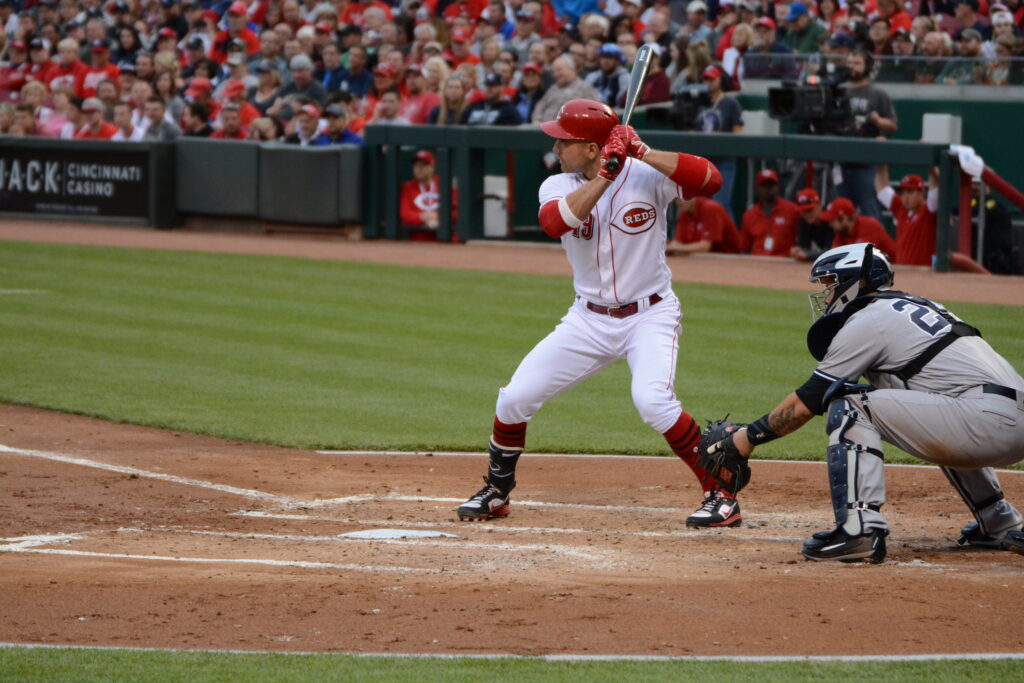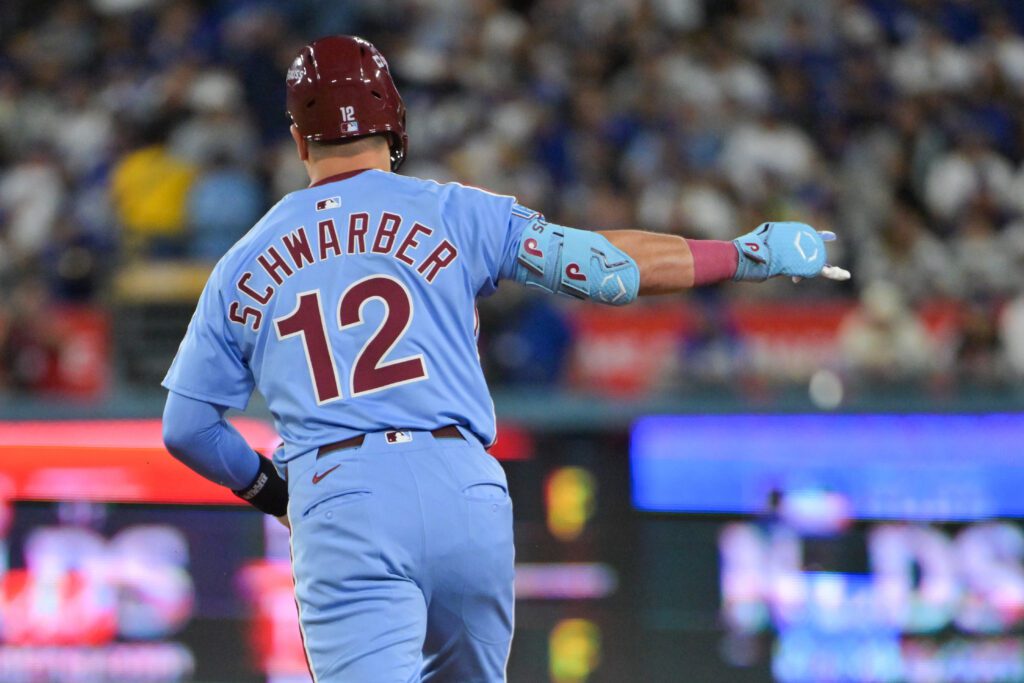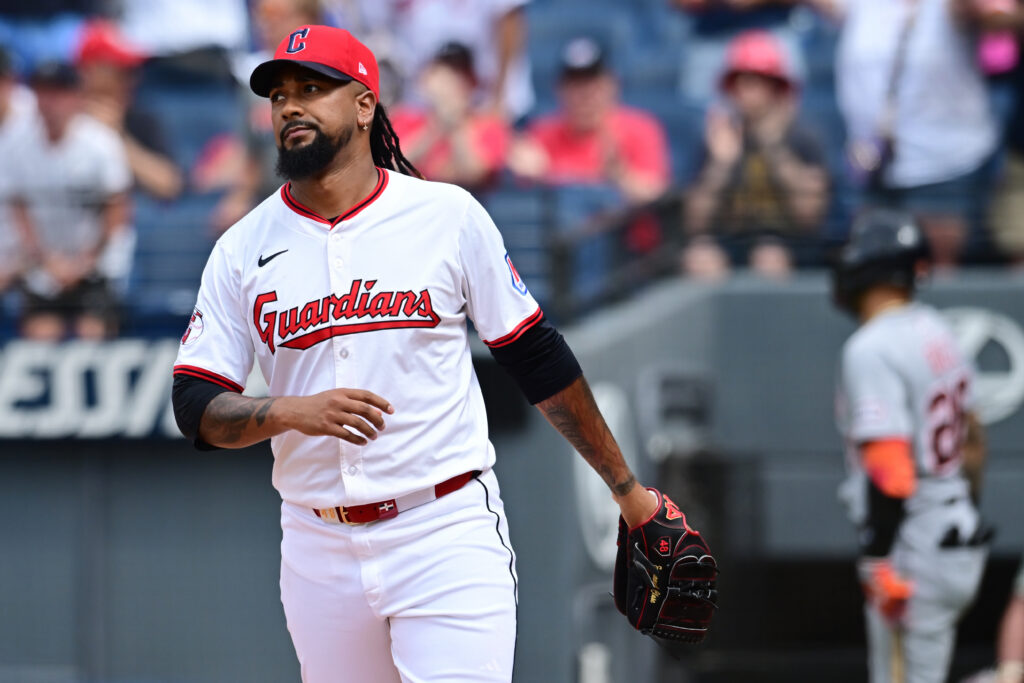This is the second article in a series that looks at the five best players at each position for the Cincinnati Reds. In this installment are first and third basemen.
The “Big Red Machine” was known primarily for its dominant offense, but it also had the benefit of being able to use several versatile stars almost anywhere in the field and in the batting order. Nowhere will that be more evident than in a look at the list of the team’s best players at each of the corner infield positions.
The Best Corner Infielders in Cincinnati Reds History
First Basemen
Honorable Mentions – Hal Morris spent 10 years with Cincinnati in two stints (1990-97 and 99-2000), winning the fielding title in 1992 and hitting better than .300 five times. His best season at the plate was 1996 when he hit .313 and set career highs with 82 runs, 165 hits, 16 home runs, and 80 RBIs. Overall, Morris batted .305 with 467 runs, 1,030 hits, 212 doubles 74 homers, and 464 RBIs in 1,049 games. In 16 playoff games, he had 13 hits, scored eight runs, and had five RBIs.
Lee May spent seven seasons with the Reds (1965-71), earning two All-Star selections and hitting at least 30 home runs three times. His best season was 1969, when he smacked 38 homers and drove in a career-high 110 runs. May had 779 hits, 147 home runs, and 449 RBIs in 761 games. In the 1970 playoffs, he totaled nine hits, six runs, two homers, and 10 RBIs in eight games.
Jake Daubert came to the Reds just in time to help them win the scandal-marked title of 1919. In the World Series that year, he had seven hits, four runs scored, and an RBI in eight games. Daubert’s best season was 1922 when he led the league with 22 triples and also set career highs with 114 runs, 205 hits, 12 home runs, and 66 RBIs while hitting .336 and winning the fielding title. In six seasons with Cincinnati (1919-24), he hit .301 with 469 runs, 939 hits, 78 triples (ninth in franchise history) and 307 RBIs in 801 games.
John Reilly was a star for the team in its American Association days. He led the league with 11 home runs in 1884, topped the circuit with 13 homers and 103 RBIs (along with 82 stolen bases) in 1888, won the fielding title the following season, and posted a league-best and franchise-record 26 triples in 1890, the club’s first year in the National League. In nine years with the Reds (1883-91), “Long John” hit .294 with 877 runs (tied for tenth on the all-time franchise list), 1,296 hits, 135 triples (third in team history), 69 home runs, 724 runs batted in and 235 stolen bases in 1,069 games.
Dan Driessen played at third base his first two seasons before moving across the diamond for the rest of his 12-year run with Cincinnati (1973-84). While often being overshadowed by bigger stars, “Cobra” (known for his quick, coiling swing) was a two-time champion who had seven hits, four runs scored, a homer, and two RBIs in 14 playoff games with the Reds. He had a career year in 1977, hitting .300 with 17 home runs and 31 stolen bases while also setting career highs with 161 hits and 91 runs batted in. Driessen finished his Reds tenure with 661 runs, 1,277 hits, 240 doubles, 133 home runs, 670 RBIs, and 152 steals in 1,480 games.
Sean Casey was a three-time All-Star during his eight seasons in Cincinnati (1998-2005). He was a steady hitter, a solid fielder (winning the 2005 fielding title), and a class act. “The Mayor” was a fan-favorite who won the Hutch Award in 1999, which was named after former Reds manager Fred Hutchinson and given to the player who best exemplifies a fighting spirit and desire. With the Reds, Casey hit .305 with 588 runs, 1,223 hits, 256 doubles, 118 home runs, and 604 RBIs in 1,075 games.
5. Jake Beckley – Although he was best known for his time in Pittsburgh, he had a solid six-year run with the Reds at the turn of the 20th century (1897-1902). “Eagle Eye” was a solid fielder who had his best season in 1900, hitting .341 with 98 runs scored, 94 runs batted in, and a career-high 190 hits. Overall, he ranks third in franchise history with a .325 average and is tied for tenth with 77 triples to go along with 592 runs, 1,126 hits, 178 doubles, 26 home runs, and 570 RBIs in 880 games. Beckley became the first player to hit three homers in a game, doing so on September 26, 1897, and he is baseball’s all-time leader in putouts with 23,755. He was elected to the Baseball Hall of Fame by the Veteran’s Committee in 1971.
4. Frank McCormick – Here is where the decisions get tougher. McCormick got a tryout after a letter-writing campaign and had a brief stint with the Reds in 1934, spent the next two years in the minors, then came up for good at the end of the 1937 season. Two years later, he won the National League MVP award after hitting .309 with 93 runs, 19 home runs, 127 runs batted in, and league-leading totals of 191 hits and 44 doubles. “Buck” was an eight-time All-Star and a three-time fielding champion who led the league in hits three times, hit better than .300 five times, and drove in more than 100 runs four times in his 10 seasons with Cincinnati (1934, 37-45). He batted .301 with 631 runs, 1,439 hits, 285 doubles, 110 homers, and 803 RBIs in 1,228 games. McCormick had 12 hits, three runs scored, and an RBI in 11 World Series games in 1939-40.
3. Ted Kluszewski – He was one of the most powerful players in the game, and his arms were so big, that he was forced to take scissors to his jersey and cut off the sleeves. “Big Klu” was a four-time All-Star who hit better than .300 and amassed at least 90 runs scored, 150 hits, 35 home runs, and 100 RBIs in each of those seasons. He finished second in the MVP voting behind Willie Mays after leading the National League with 49 home runs and 141 RBIs in 1954, and he smacked 47 homers, drove in 113 runs, and scored 116 the following year. Not only could Kluszewski hit, but he also was stellar at first base, winning five fielding titles during his 11 seasons (1947-57) with the Reds and Redlegs, (as they were called from 1954-58). He batted .302 and totaled 745 runs, 1,499 hits, 244 doubles, 251 home runs (sixth in franchise history), and 886 RBIs (ninth) in 1,339 games. Kluszewski’s career fell apart, and he lost most of his power after suffering a slipped disc in a clubhouse fight late in the 1956 season.
2. Tony Perez – He was one of those versatile players mentioned in the opening. Anastacio “Tony” Perez played his first three years at first base, moved over to third for five seasons (more on that later), came back across the diamond for five more years, and stayed at first when he returned for three seasons almost a decade later. In 16 seasons with the Reds (1964-76 and 84-86), “Big Dog” was a seven-time All-Star, earned a fielding title in 1974, and won the Lou Gehrig Award (for character and integrity) in 1980. He had at least 20 home runs in a season eight times and drove in at least 100 runs in six seasons. Overall, Perez hit .283 and ranks second in franchise history with 1,192 RBIs, fourth with 287 home runs, seventh with 1,934 hits, 339 doubles, and 1,948 games played, and ninth with 936 runs. In 42 playoff games, the two-time champion had 38 hits, 16 runs, six homers and 25 RBIs. Perez was inducted into the Baseball Hall of Fame in 2000.
1. Joey Votto – He is one of the few 21st-century players that will appear on any of these lists. Votto is in his 17th season with the Reds (2007-present) and is a six-time All-Star who won a gold glove in 2011. He was named National League MVP and won the Hank Aaron Award (for the best offensive performer) in 2010 when he hit .324 with 177 hits, and 36 doubles to go with career highs of 106 runs, 37 home runs, 113 RBIs, and 16 stolen bases. Votto was also the MVP runner-up and won the Lou Gehrig Award in 2017 after hitting .320 with 196 runs, 179 hits 34 doubles, 36 homers, and 100 runs batted in. He has led the league seven times in on-base percentage, five times in walks, and once in doubles, when he hit 40 in 2011.
The nickname “Votto-matic” certainly fits, as he has been a steady performer and a fan favorite who has been the one constant through the lean years during his Reds tenure. He has hit .295 and ranks high on the franchise list in most offensive categories. Votto is second in home runs (355), doubles (458) and total bases (3,693), third in RBIs (1,138), fourth in runs (1,165), fifth in hits (2,126) and sixth in games (2,040). He also has 10 hits, three runs scored, and an RBI in 11 career playoff games.
Third Basemen
Honorable Mentions – The third base for the Reds does not have the star power like they do across the diamond, but they do have depth and a few intangibles. For Arlie Latham, a starter in the late 19th century (1890-95) his was speed. Walter Arlington Latham had at least 20 stolen bases five times with the Reds, including 87 in 1891 and 62 three years later. Overall, he hit .279 with 591 runs, 794 hits, and 290 RBIs in 698 games, and his 340 steals rank fifth on the all-time franchise list.
Aaron Boone was a solid player in seven seasons with Cincinnati (1997-2003), but he is best known for what came after. Boone hit .271 with 646 hits, 86 home runs, and 362 RBIs in 668 games with the Reds. The 2003 All-Star was sent to the Yankees at the trade deadline and paid big dividends, hitting a game-winning home run against the rival Red Sox in Game 7 of the American League Championship Series. Although they lost to the Marlins in the World Series, the Yankees still have a place for Boone, as he is the team’s current manager.
Todd Frazier was a two-time All-Star who won the Home Run Derby at the 2015 event at his home at Great American Ball Park. He had 586 hits, 108 home runs, and 324 RBIs in 633 games in five seasons with Cincinnati (2011-15). “The ToddFather” also went 2-for-10 with a double and an RBI in five playoff games for the Reds.
Billy Werber played just three seasons with Cincinnati (1939-41), but the team went to the World Series twice. He led the league with 115 runs scored in 1939 and won the fielding title the following year. Werber hit .272 with 435 hits, 276 runs, and 151 RBIs in 399 games. He had 14 hits, six runs, two home runs and four RBIs in 11 World Series games.
Grady Hatton was not quite a throwback to the no-hit, all-field infielders of the early 20th century, but was a bit of a light hitter at the “hot corner” Hatton won two fielding titles and hit .254 in nine seasons with the Reds (1946-54), but hit lone All-Star appearance came in 1952, when he hit just .212. Nicknamed “Grade A” for his integrity, Hatton had 454 runs, 843 hits, 81 home runs, and 429 RBIs in 970 games.
Eugenio Suarez, on the other hand, is very much a modern player. In 2019, he hit .271 with 49 homers and 103 RBIs, but he also led the National League with 189 strikeouts. A 2018 All-Star, Suarez had 828 hits, 189 home runs, 524 RBIs, and 965 strikeouts in 916 games over seven seasons (2015-21).
5. Warren “Hick” Carpenter – He played for the previous Cincinnati Stars National League franchise in 1880 and was the third basemen for the entirety of the team’s eight-year tenure in the American Association (1882-89). Carpenter led the new league with 129 runs and 67 RBI and also won the fielding title in his first season. In 1888, he set career highs with 147 hits, 67 RBIs (which tied his best total) and 59 stolen bases. Carpenter had 618 runs, 1,001 hits, 469 RBIs, and 158 steals in 892 games.
4. Henry “Heinie” Groh – He was a great bunter and a star during the decade that ended with the Reds winning their first World Series. In 1918, Groh set career-highs with 91 runs, 182 hits, and 39 doubles, with those last two stats leading the league. The following year, he topped the National League with 86 runs and 28 doubles. Groh won two fielding titles in nine seasons with Cincinnati (1913-21), and he hit .298 and totaled 663 runs, 1,323 hits, 224 doubles, 75 triples, 408 RBIs, and 158 stolen bases in 1,211 games. In the eight-game World Series in 1919, Groh had five hits, six runs scored, and two RBIs.
3. Chris Sabo – He was a three-time All-Star who also won two fielding titles during his seven seasons with the Reds (1988-93 and 96). Nicknamed “Spuds” by manager Pete Rose due to his resemblance to Spuds MacKenzie, the terrier in the Bud Light beer commercials of the time, the Rec Specs-wearing Sabo won the Rookie of the Year award in 1988 after posting a .271-11-44 stat line and setting career highs with 40 doubles and 46 stolen bases.
Injuries ravaged him throughout his career, but he hit .301 with 175 hits, 26 homers, and 88 RBIs in 1991 (all career highs). He spent two injury-plagued seasons with three teams in 1994-95 before returning to the Reds for one final season (which included an infamous corked bat incident). He ended his Reds career with 434 runs, 812 hits, 104 home runs, 373 runs batted in, and 116 steals in 818 games. In May, Sabo was named as manager of the Mumbai Cobras in the new Baseball United League, which is trying to bring baseball to the Middle East and Southeast Asia.
2. Pete Rose – While his Reds career ended with three seasons at first base from 1984-86, his final four years with the “Big Red Machine” team came at third base, which he occupied from 1975-79. Rose was an All-Star in each of those seasons, and he also won the fielding title and the Roberto Clemente Award (for sportsmanship and community involvement) in 1976. Rose led the league with 215 hits in 1976, and he also topped in National League in doubles three times (including 51 in 1978 which is tied for the most in franchise history) and runs twice. In his time at third base, Rose batted .314 with 440 runs, 827 hits, 253 RBIs, and 178 stolen bases.
He totaled 24 hits, 10 runs, four doubles, a home run, and seven RBIs in 17 playoff games during the four-year period. Rose was a two-time champion, and he was named World Series MVP in 1975 after going 10-for-27 with three runs scored and two RBIs in the seven-game win over the Red Sox. However, his greatest accomplishment during this time might be tying the National League record with a 44-game hitting streak in 1978 that lasted from June 14 to July 31 (“Wee Willie” Keeler, of the N.L.’s Baltimore Orioles originally set the record in 1897). Later in the season, he became the youngest player to join the 3,000-hit club.
1. Tony Perez – “Big Dog” was known for his time at first base, but he had an impressive five-season run (1967-71) at the “hot corner.” Perez was selected to the All-Star team four times in that span, including 1967, when he was named game MVP after hitting a game-winning home run in the 15th inning. He finished third in the National League MVP voting in 1970 after setting career highs with a .317 average, 107 runs, 186 hits, 40 home runs and 129 runs batted in. During his time at third base, Perez batted .290 with 453 runs, 885 hits, 146 homers, and 536 RBIs in 792 games. He had five hits, three runs, two doubles, a home run, and two RBIs in the 1970 playoffs, which ended with a loss to the Orioles in the World Series.
Upcoming Stories
Cincinnati Reds Catchers and Managers
Cincinnati Reds Second Basemen and Shortstops – coming soon
Cincinnati Reds Outfielders – coming soon
Cincinnati Reds Pitchers – coming soon
Previous Series
A look back at the Chicago White Sox
Chicago White Sox Catchers and Managers
Chicago White Sox First and Third Basemen and Designated Hitters
Chicago White Sox Second Basemen and Shortstops
Chicago White Sox Outfielders
Chicago White Sox Pitchers
A look back at the Chicago Cubs
Chicago Cubs Catchers and Managers
Chicago Cubs First and Third Basemen
Chicago Cubs Second Basemen and Shortstops
Chicago Cubs Outfielders
Chicago Cubs Pitchers
A look back at the Boston Red Sox
Boston Red Sox Catchers and Managers
Boston Red Sox First and Third Basemen
Boston Red Sox Second Basemen and Shortstops
Boston Red Sox Outfielders and Designated Hitters
Boston Red Sox Pitchers
A look back at the Baltimore Orioles
Baltimore Orioles Catchers and Managers
Baltimore Orioles First and Third Basemen
Baltimore Orioles Second Basemen and Shortstops
Baltimore Orioles Outfielders and Designated Hitters
Baltimore Orioles Pitchers
A look back at the Atlanta Braves
Catchers and Managers
First and Third Basemen
Second Basemen and Shortstops
Outfielders
Pitchers
A look back at the Arizona Diamondbacks
Catchers and Managers
First and Third Basemen
Second Basemen and Shortstops
Outfielders
Pitchers



